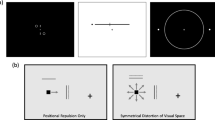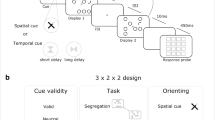Summary
In the Simon task the spatial position of the stimulus, though task irrelevant, influences speed of response. We (Umiltà & Nicoletti, 1992) proposed that the orienting of attention to the imperative stimulus produces a Stroop-like interference. This paper reports the results of three experiments that provide empirical support for two predictions of this hypothesis. One is that the stimulus spatial code is formed with relation to the position to which attention is directed. The other prediction is that the Simon effect is obtained on condition that attention can orient to the stimulus.
Similar content being viewed by others
References
Castiello, U., & Umiltà, C. (1990). Size of the attentional focus and efficiency of processing. Acta Psychologica, 73, 195–209.
Eriksen, C. W., & St James, J. D. (1986). Visual attention within and around the field of focal attention: A zoom lens model. Perception & Psychophysics, 40, 225–240
Hasbroucq, T., & Guiard, Y. (1991). Stimulus-response compatibility and the Simon effect: Toward a conceptual clarification. Journal of Experimental Psychology: Human Perception and Performance, 5, 246–266.
Hasbroucq, T., Guiard, Y., & Ottomani, L. (1990). Principles of response determination. Bulletin of the Psychonomic Society, 28, 327–330.
Hedge, A., & Marsh, N. W. A. (1975). The effect of irrelevant spatial correspondences on two-choice response-time. Acta Psychologica, 39, 427–439.
Kornblum, S., Hasbroucq, T., & Osman, A. (1990). Dimensional overlap: Cognitive basis for stimulus-response compatibility — A model and a taxonomy. Psychological Review, 97, 253–270.
MacLeod, C. M. (1991). Half a century of research on the Stroop effect: An integrative review. Psychological Bulletin, 109, 163–203.
McCann, R. S., & Johnston, J. C. (1992). Locus of single-channel bottleneck in dual task interference. Journal of Experimental Psychology: Human Perception and Performance, 18, 471–484.
Muller, H. J., & Rabbit, P. M. A. (1989). Reflexive and voluntary orienting of visual attention: Time course of activation and resistance to interruption. Journal of Experimental Psychology: Human Perception and Performance, 15, 315–330.
Nicoletti, R., Anzola, G. P., Luppino, G, Rizzolatti, G., & Umiltà, C. (1982). Spatial compatibility effects on the same side of the body midline. Journal of Experimental Psychology: Human Perception and Performance, 8, 664–673.
Nicoletti, R., & Umiltà, C. (1984). Right-left prevalence in spatial compatibility. Perception & Psychophysics, 35, 333–343.
Nicoletti, R., & Umiltà, C. (1989). Splitting visual space with attention. Journal of Experimental Psychology: Human Perception and Performance, 15, 164–169.
O'Leary, M. J., & Barber, P J. (1993). Interference effects in the Stroop and Simon paradigms. Journal of Experimental Psychology: Human Perception and Performance, 19, 830–844.
Osman, A., Kornblum, S., & Meyer, D. E. (1990). Does motor programming necessitate response execution? Journal of Experimental Psychology: Human Perception and Performance, 16, 183–198.
Pashler, H., & Baylis, G. (1991 a). Procedural learning: Locus of practice effects in speeded choice-tasks. Journal of Experimental Psychology: Learning, Memory, and Cognition, 17, 20–32.
Pashler, H., & Baylis, G. (1991 b). Procedural learning: Intertrial repetition effect in speeded-choice tasks. Journal of Experimental Psychology: Learning, Memory, and Cognition, 17, 33–48.
Rizzolatti, G., Riggio, L., Dascola, I., & Umiltà, C. (1987). Reorienting of attention across the horizontal and vertical meridians: Evidence in favor of a premotor theory of attention. Neuropsychologia, 25, 31–40.
Simon, J. R. (1969). Reactions toward the source of stimulation. Journal of Experimental Psychology, 81, 174–176.
Simon, J. R. (1990). The effect of an irrelevant directional cue on human information processing. In R. W. Proctor & T. G. Reeve (Eds.), Stimulus-response compatibility: An integrated perspective (pp. 31–88). Amsterdam: North-Holland.
Simon, J. R., Sly, P. E., & Vilapakkam, S. (1981). Effect of compatibility of S-R mapping on reactions toward the stimulus source. Acta Psychologica, 47, 63–81.
Stoffer, T. H. (1991). Attentional focussing and spatial stimulus-response compatibility. Psychological Research, 53, 127–135
Teichner, W. H., & Krebs, M. J., (1974). Laws of visual choice reaction time. Psychological Review, 81, 75–98.
Umiltà, C. (1991). Problems of the salient-features coding hypothesis: Comment on Weeks and Proctor. Journal of Experimental Psychology: General, 120, 83–86.
Umiltà, C., & Liotti, M. (1987). Egocentric and relative spatial codes in S-R compatibility. Psychological Research, 49, 81–90.
Umiltà, C., & Nicoletti, R. (1985). Attention and coding effects in S-R compatibility due to irrelevant spatial cues. In M. I. Posner & O. S. M. Marin (Eds.), Attention and performance XI (pp. 457–471). Hillsdale, NJ: Erlbaum.
Umiltà, C., & Nicoletti, R. (1990). Spatial stimulus-response compatibility. In R. W. Proctor & T. G. Reeve (Eds.), Stimulus-response compatibility: An integrated perspective (pp. 89–116). Amsterdam: North-Holland.
Umiltà, C., & Nicoletti, R. (1992). An integrated model of the Simon effect. In J. Alegria, D. Holender, J. Junca de Morais, & M. Radeau (Eds.), Analytic approaches to human cognition (pp. 331–349). Amsterdam: Elsevier.
Umiltà, C., Riggio, L., Dascola, I., & Rizzolatti, G. (1991). Differential effects of central and peripheral cues on the reorienting of spatial attention. European Journal of Cognitive Psychology, 3, 247–267.
Verfaellie, M., Bowers, D., & Heilman, K. M. (1988). Attentional factors in the occurrence of stimulus-response compatibility effects. Neuropsychologia, 26, 435–444.
Verfaellie, M., Bowers, D., & Heilman, K. M. (1990). Attentional processes in spatial stimulus-response compatibility. In R. W. Proctor & T. G. Reeve (Eds.), Stimulus-response compatibility: An integrated perspective (pp. 261–275). Amsterdam: North-Holland.
Wallace, R. J. (1971). S-R compatibility and the idea of a response code. Journal of Experimental Psychology, 88, 354–360.
Wallace, R. J. (1972). Spatial S-R compatibility effects involving kinesthetic cues. Journal of Experimental Psychology, 93, 163–168.
Author information
Authors and Affiliations
Additional information
Some of the results of Experiments 1 and 2 were reported briefly in Umiltà and Nicoletti (1992)
Rights and permissions
About this article
Cite this article
Nicoletti, R., Umiltà, C. Attention shifts produce spatial stimulus codes. Psychol. Res 56, 144–150 (1994). https://doi.org/10.1007/BF00419701
Issue Date:
DOI: https://doi.org/10.1007/BF00419701




